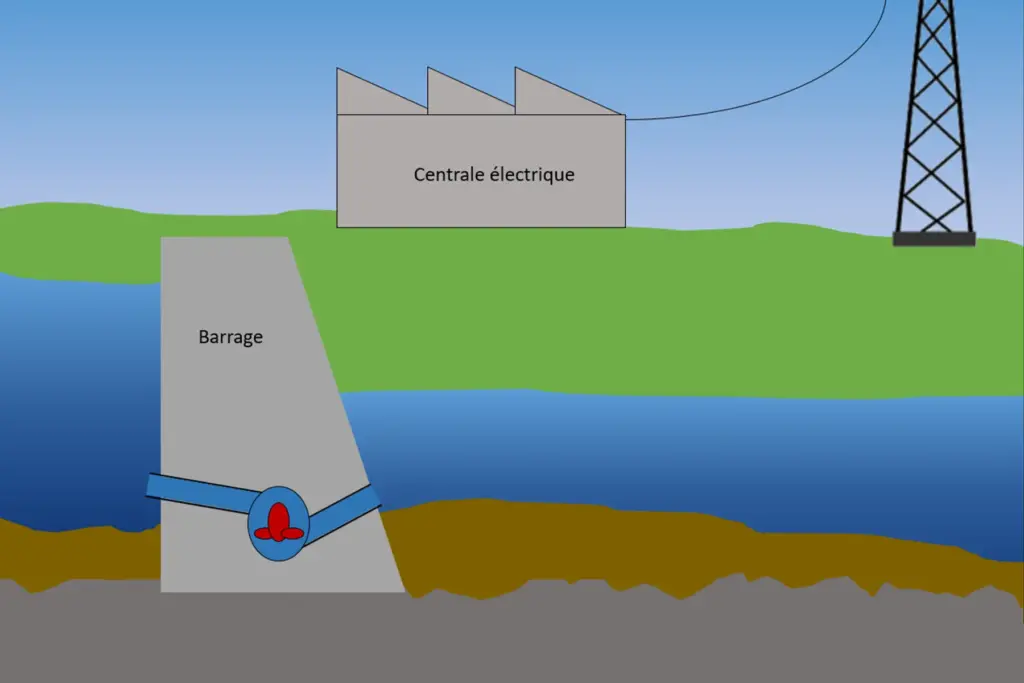A run-of-river power plant is a renewable source of energy that offers the following advantages benefits considerable. It uses hydropower from rivers to generate electricity, reducing greenhouse gas emissions and promoting the transition to cleaner energy. However, it also presents a number of disadvantages such as the impact on the aquatic ecosystem and the need to regulate the water supply.
Pelton turbine V2.0 - 1000W
[arve url="https://www.youtube.com/embed/DBFrGtQkz8s "/]
What are the disadvantages of run-of-river power plants?
Run-of-river power plants have certain disadvantages major. First of all, they are dependent on weather conditions and seasonal variations. These power plants depend on the flow of water, which can be subject to considerable fluctuations. In periods of drought, or in winter when water flow is low, electricity production can be considerably reduced.
In addition, run-of-river power plants can lead to significant environmental impacts. The construction of the dams required for this type of power plant can have harmful consequences for aquatic ecosystems and biodiversity. These dams can fragment natural habitats and disrupt the movement of fish and other aquatic species.
In addition, run-of-river power plants can also cause water use conflicts. In times of drought, there can be competition between the use of water for power generation and other uses such as agricultural irrigation, drinking water supply, etc. This can create tensions between different water users and lead to problems of access to this vital resource. This can create tensions between different water users and lead to problems of access to this vital resource.
Last but not least, run-of-river power plants have a limited storage capacity. Unlike reservoir hydropower plants, which can store water and adjust their output to meet demand, run-of-river plants do not have this capability. As a result, they are less flexible and less able to respond to variations in electricity demand.
In conclusion, although run-of-river power plants are a renewable energy source, they have significant disadvantages linked to their dependence on weather conditions, their environmental impacts, conflicts over water use and their limited storage capacity.
What are the advantages and disadvantages of hydraulic power plants?
Advantages :
- Clean energy production : Hydropower plants generate electricity from the energy of moving water, generating no greenhouse gas emissions or atmospheric pollutants.
- Renewable and sustainable energy: Unlike fossil fuels, water is an abundant, renewable natural resource. Hydropower plants can therefore generate electricity continuously and reliably.
- Stable production : Hydropower plants are able to provide constant, predictable electricity production, which facilitates power grid management.
Disadvantages :
- Environmental impact : The construction of large hydroelectric power plants can result in the drowning of vast areas of land, with consequences for local ecosystems and biodiversity. In addition, dams can disrupt the natural flow of rivers, affecting aquatic ecosystems.
- Population displacement : The construction of large hydropower plants often requires the displacement of local populations living in flooded areas. This can lead to social problems, such as the loss of farmland and traditional living areas.
- High initial costs : The construction of dams and associated infrastructure represents a significant financial investment. What's more, the upkeep and maintenance of hydropower plants also entail significant costs.
In conclusion, Hydropower plants offer considerable advantages in terms of clean, renewable energy production. However, they need to be developed responsibly to minimize their impact on the environment and local populations. High initial costs can also pose challenges for large-scale implementation.
What are the disadvantages of water power?
Water power, also known as hydroelectricity, has certain disadvantages. First and foremostdam construction can lead to destruction of aquatic and terrestrial ecosystems. The creation of artificial reservoirs can submerge fertile farmland and residential areas, forcing local populations to relocate.
In additionThe construction of dams also has an impact on the biodiversity. Dams block fish migration, altering their reproductive cycles and threatening their survival. Some animals also depend on rivers for their habitat and food, and river modification can disrupt their ecosystems.
In additionIt's important to note that hydroelectric power is subject to the following conditions weather conditions. In times of drought, reservoirs can run dry, reducing electricity production. This means that water power is not a constant, reliable source of energy.
FinallyThe construction of dams requires substantial financial investment. Construction costs can be high, as can the cost of upkeep and maintenance of hydroelectric infrastructure. This can lead to higher electricity prices for consumers.
Despite these drawbacks, it should be noted that hydropower remains a renewable and relatively clean source of energy. The advantages and disadvantages need to be considered in the context of each specific hydropower project.
What are the advantages and disadvantages of a dam?
A dam has a number of advantages and disadvantages.
Advantages :
- Power generation : A dam generates electricity by harnessing the hydraulic force of water. This can help reduce dependence on fossil fuels and promote renewable energies.
- Flood control : Dams are often used to regulate the flow of rivers, thus preventing flooding in the event of high water.
- Drinking water supply : Some dams provide drinking water for neighboring communities. They can also be used to irrigate farmland.
- Recreation and tourism : Reservoirs formed by dams often offer recreational opportunities, such as water sports and fishing. They can also attract tourists, contributing to local economic development.
Disadvantages :
- Environmental impact : The construction of a dam can lead to the destruction of natural habitats, the disruption of ecosystems and the disappearance of animal and plant species. What's more, the formation of a reservoir can submerge farmland, forests and residential areas.
- Population displacement : The construction of a dam may require the displacement of local populations, often resulting in social and economic disruption.
- Sedimentation : Dams tend to retain sediment carried by water, which can lead to a reduction in reservoir storage capacity and environmental problems downstream.
- Financial costs : Building a dam can be very costly, in terms of design, construction and maintenance. In addition, there may be costs associated with managing environmental and social impacts.
It is important to consider these advantages and disadvantages when planning and implementing dam projects, in order to minimize negative impacts and maximize benefits for society and the environment.
In conclusion, run-of-river power plants offer both significant advantages and disadvantages. On the one hand, they are a clean, renewable source of energy, helping to reduce greenhouse gas emissions and protect the environment. What's more, they are often less expensive to build and maintain than other types of power plant.
On the other hand, run-of-river power plants are highly dependent on available water resources, which can pose problems in the event of drought or seasonal variations in river flows. What's more, the damming required to create these power plants can have significant environmental consequences, such as the destruction of natural habitats and the disruption of aquatic ecosystems.
It is therefore essential to weigh up the pros and cons carefully before deciding to build a run-of-river power plant. In some scenarios, it may be an efficient and sustainable option for meeting energy needs, while in others it may be preferable to explore other renewable energy sources, such as solar or wind power.
In a nutshellRun-of-river power plants offer significant energy potential, but their impact on the environment needs to be carefully assessed. Striking a balance between power generation and the preservation of aquatic ecosystems is fundamental to ensuring a sustainable future for our planet.








